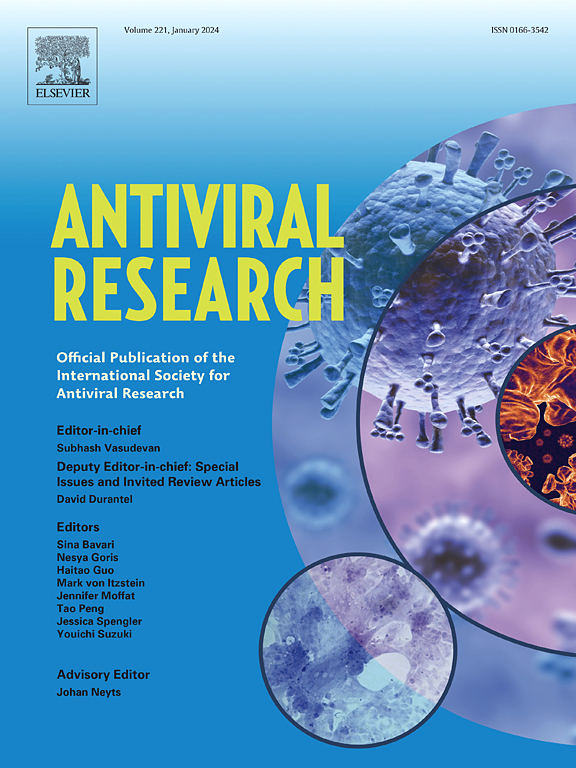Structural and quantitative comparison of viral infection-associated N-glycans in plasma from humans, pigs, and chickens: Greater similarity between humans and chickens than pigs
IF 4
2区 医学
Q1 PHARMACOLOGY & PHARMACY
引用次数: 0
Abstract
Host N-glycans play an essential role in the attachment, invasion, and infection processes of viruses, including zoonotic infectious diseases. The similarity of N-glycans in the trachea and lungs of humans and pigs facilitates the cross-species transmission of influenza viruses through respiratory tracts. In this study, the structure and quantity of N-glycans in the plasma of humans, pigs, and chickens were analyzed using liquid chromatography-quadrupole-Orbitrap-tandem mass spectrometry. N-glycans in humans (35), pigs (28), and chickens (53) were identified, including the most abundant, species-common, and species-specific N-glycans. Among the N-glycans (relative quantity >0.5%), the sialic acid derivative of N-acetylneuraminic acid was identified in humans (the sum of the relative quantities of each; 64.3%), pigs (45.5%), and chickens (64.4%), whereas N-glycolylneuraminic acid was only identified in pigs (18.1%). Sialylated N-glycan linkage isomers are the influenza virus receptors (α2-6 in humans, α2-3 and α2-6 in pigs, and α2-3 in chickens). Only α2-6 linkages (human, 58.2%; pig, 44.8%; and chicken, 60.6%) were more abundant than α2-3/α2-6 linkages (human, 4.6%; pig, 0.6%; and chicken, 3.4%) and only α2-3 linkages (human, 1.5%; pig, 0.1%; and chicken, 0.4%). Fucosylation, which can promote viral infection through immune modulation, was more abundant in pigs (76.1%) than in humans (36.4%) and chickens (16.7%). Bisecting N-acetylglucosamine, which can suppress viral infection by inhibiting sialylation, was identified in humans (10.3%) and chickens (16.9%), but not in pigs. These results indicate that plasma N-glycans are similar in humans and chickens. This is the first study to compare plasma N-glycans in humans, pigs, and chickens.
人、猪和鸡血浆中病毒感染相关 N-聚糖的结构和定量比较:人和鸡的相似性高于猪。
宿主 N-糖在病毒(包括人畜共患传染病)的附着、入侵和感染过程中起着至关重要的作用。人和猪气管和肺中的 N-糖具有相似性,这为流感病毒通过呼吸道进行跨物种传播提供了便利。本研究采用液相色谱-四极杆-轨道阱-串联质谱法分析了人、猪和鸡血浆中 N-糖的结构和数量。共鉴定出人(35 个)、猪(28 个)和鸡(53 个)血浆中的 N-聚糖,包括含量最高的 N-聚糖、物种共有的 N-聚糖和物种特有的 N-聚糖。在 N-聚糖(相对含量大于 0.5%)中,人(各相对含量之和;64.3%)、猪(45.5%)和鸡(64.4%)都鉴定出了 N-乙酰神经氨酸的硅醛酸衍生物,而只有猪(18.1%)鉴定出了 N-乙酰神经氨酸。硅氨酰化 N-聚糖连接异构体是流感病毒受体(人为 α2-6,猪为 α2-3 和 α2-6,鸡为 α2-3)。只有α2-6连接(人,58.2%;猪,44.8%;鸡,60.6%)的含量高于α2-3/α2-6连接(人,4.6%;猪,0.6%;鸡,3.4%)和α2-3连接(人,1.5%;猪,0.1%;鸡,0.4%)。可通过免疫调节促进病毒感染的岩藻糖基化在猪体内的含量(76.1%)高于人(36.4%)和鸡(16.7%)。在人类(10.3%)和鸡(16.9%)中发现了双截N-乙酰葡糖胺,它可以通过抑制硅氨酰化来抑制病毒感染,但在猪中却没有发现。这些结果表明,人和鸡的血浆 N-聚糖相似。这是首次比较人、猪和鸡血浆 N-糖的研究。
本文章由计算机程序翻译,如有差异,请以英文原文为准。
求助全文
约1分钟内获得全文
求助全文
来源期刊

Antiviral research
医学-病毒学
CiteScore
17.10
自引率
3.90%
发文量
157
审稿时长
34 days
期刊介绍:
Antiviral Research is a journal that focuses on various aspects of controlling viral infections in both humans and animals. It is a platform for publishing research reports, short communications, review articles, and commentaries. The journal covers a wide range of topics including antiviral drugs, antibodies, and host-response modifiers. These topics encompass their synthesis, in vitro and in vivo testing, as well as mechanisms of action. Additionally, the journal also publishes studies on the development of new or improved vaccines against viral infections in humans. It delves into assessing the safety of drugs and vaccines, tracking the evolution of drug or vaccine-resistant viruses, and developing effective countermeasures. Another area of interest includes the identification and validation of new drug targets. The journal further explores laboratory animal models of viral diseases, investigates the pathogenesis of viral diseases, and examines the mechanisms by which viruses avoid host immune responses.
 求助内容:
求助内容: 应助结果提醒方式:
应助结果提醒方式:


